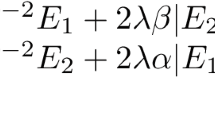Abstract
In this paper we study a model which describes the relation of the matter and the electromagnetic field from a unitarian standpoint in the spirit of the ideas of Born and Infeld. This model, introduced in [1], is based on a semilinear perturbation of the Maxwell equation (SME). The particles are described by the finite energy solitary waves of SME whose existence is due to the presence of the nonlinearity. In the magnetostatic case (i.e. when the electric field \({\bf E}=0\) and the magnetic field \({\bf H}\) does not depend on time) the semilinear Maxwell equations reduce to semilinear equation where “\(\nabla\times \)” is the curl operator, f′ is the gradient of a smooth function \(f:{\mathbb{R}}^3\to{\mathbb{R}}\) and \({\bf A}:{\mathbb{R}}^3\to{\mathbb{R}}^3\) is the gauge potential related to the magnetic field \({\bf H}\) (\({\bf H}=\nabla\times {\bf A}\)). The presence of the curl operator causes (1) to be a strongly degenerate elliptic equation. The existence of a nontrivial finite energy solution of (1) having a kind of cylindrical symmetry is proved. The proof is carried out by using a variational approach based on two main ingredients: the Principle of symmetric criticality of Palais, which allows to avoid the difficulties due to the curl operator, and the concentration-compactness argument combined with a suitable minimization argument.
Keywords: Maxwell equations, Natural constraint, Minimizing sequence
Mathematics Subject Classification (2000): 35B40, 35B45, 92C15
Similar content being viewed by others
References
1. Benci, V., Fortunato, D.: Towards a unified field theory for Classical Electrodynamics. Arch. Rat. Mech. Anal. 173, 379–414 (2004)
2. Berestycki, H., Lions, P.L.: Nonlinear scalar field equatios, I - Existence of a ground state. Arch. Rat. Mech. Anal. 82, 313–345 (1983)
3. Born, M., Infeld, L.: Foundations of the new field theory. Proc. R. Soc. Lon. A 144, 425–451 (1934)
4. Jackson, J.D.: Classical electrodynamics. John Wiley & Sons, New York (1962)
5. Landau, L., Lifchitz, E.: Théorie des champs. Editions Mir, Moscou (1970)
6. Lions, P.L.: The concentration-compactness principle in the calculus of variations. The locally compact case. Part I. Ann. Inst. H. Poincaré Anal. Non Linéaire 1, 109–145 (1984)
7. Lions, P.L.: The concentration-compactness principle in the calculus of variations. The locally compact case. Part II. Ann. Inst. H. Poincaré Anal. Non Linéaire 1, 223–283 (1984)
8. Palais, R.S.: The principle of symmetric criticality. Comm. Math. Phys. 69, 19–30 (1979)
9. Thirring, W.: Classical mathematical physics. Springer, New York (1997)
10. Yang, Y.: Solitons in field theory and and nonlinear analysis. Springer, New York (2000)
Author information
Authors and Affiliations
Rights and permissions
About this article
Cite this article
Azzollini, A., Benci, V., D’Aprile, T. et al. Existence of static solutions of the semilinear Maxwell equations. Ricerche mat. 55, 123–137 (2006). https://doi.org/10.1007/s11587-006-0016-8
Received:
Accepted:
Issue Date:
DOI: https://doi.org/10.1007/s11587-006-0016-8



